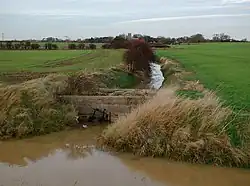St Helen's Church, Skeffling
| Church of St Helen, Skeffling | |
|---|---|
 | |
| Location | Skeffling, Holderness, East Riding of Yorkshire, England |
| Coordinates | 53°39′00″N 0°04′21″E / 53.65°N 0.0725°E |
| Built | 15th century |
| Restored | 19th/20th centuries |
| Governing body | Friends of Friendless Churches |
Listed Building – Grade I | |
| Official name | Church of St Helen, Skeffling |
| Designated | 16 December 1966 |
| Reference no. | 1161165 |
Listed Building – Grade II | |
| Official name | Cross 6m south of Church of St Helen |
| Designated | 27 February 1987 |
| Reference no. | 1083463 |
 Location in the East Riding of Yorkshire | |
St Helen's is a redundant church in the village of Skeffling, Holderness, in the East Riding of Yorkshire, England (grid reference TA370190). Dating from the mid-15th century, the church was dedicated to St Helena. It is recorded in the National Heritage List for England as a designated Grade I listed building and is under the care of the Friends of Friendless Churches.
History
The Church of St Helen dates from around 1460.[1] It stands in an isolated setting in the village of Skeffling on the edge of the North Sea.[a][2] It was restored in the very early 20th century,[3] and again in 1984–85.[1] When active, the church was within the Deanery of South Holderness within the Diocese of York.[4] Faced with steeply declining congregations,[b] the church was declared redundant in 2018.[6] In 2021 it was taken into the care of the Friends of Friendless Churches.[1]
Architecture and description
St Helen's consists of a nave with porch, a chancel and a western tower. David Neave, writing in his Yorkshire: York and the East Riding volume in the Buildings of England series, revised and re-issued in 2005, notes the tower's "fine Perpendicular Gothic" design.[3] The building material is local cobblestone.[7] The interior contains a collection of 18th-century funerary monuments, many commemorating members of the Holme and the Bee families, who were major local landowners.[7] The church is a Grade I listed building.[7] A cross in the churchyard contemporaneous with the church has its own Grade II listing.[8] It is topped by a sundial dating from the late 18th century.[3]
Gallery
-
 Plaque commemorating the 1980s restoration
Plaque commemorating the 1980s restoration -
 The church in its isolated, rural, setting
The church in its isolated, rural, setting -
.jpg) Interior
Interior
Notes
- ^ The Holderness peninsula was described by Philip Larkin, a frequent visitor from his home in Kingston upon Hull; "Fast-shadowed wheat-fields, running high as hedges, Isolate villages where removed lives Loneliness clarifies. Here silence stands Like heat".[2]
- ^ According to the 2011 UK census, Skeffling parish had a population of 149.[5]
References
- ^ a b c "St Helen's Church, Skeffling". Friends of Friendless Churches. Retrieved 27 July 2025.
- ^ a b "St Helen's Skeffling" (PDF). Friends of Friendless Churches. November 2021. Retrieved 27 July 2025.
- ^ a b c Pevsner & Neave 2005, p. 683.
- ^ "The Benefice". St Patrick's Church, Patrington. Retrieved 27 July 2025.
- ^ UK Census (2011). "Local Area Report – Skeffling Parish (1170211256)". Nomis. Office for National Statistics. Retrieved 27 July 2025.
- ^ Davidson-Brett, James (13 June 2018). "St Helen's Skiffling: Mission and Pastoral Measure" (PDF). Church of England. Retrieved 27 July 2025.
- ^ a b c Historic England. "Church of St Helen, Skeffling (Grade I) (1161165)". National Heritage List for England. Retrieved 27 July 2025.
- ^ Historic England. "Cross 6m south of Church of St Helen (Grade II) (1083463)". National Heritage List for England. Retrieved 27 July 2025.
Sources
- Pevsner, Nikolaus; Neave, David (2005). Yorkshire: York and the East Riding. The Buildings of England. New Haven and London: Yale University Press. ISBN 0-300-09593-7.